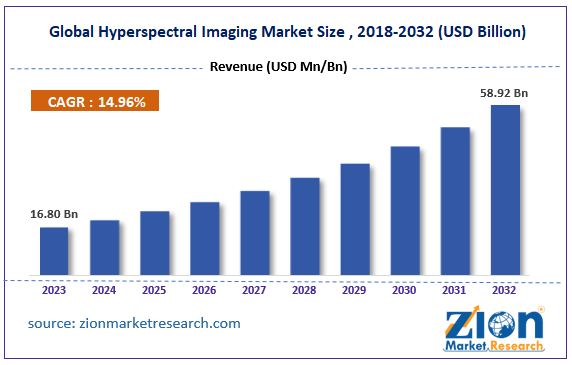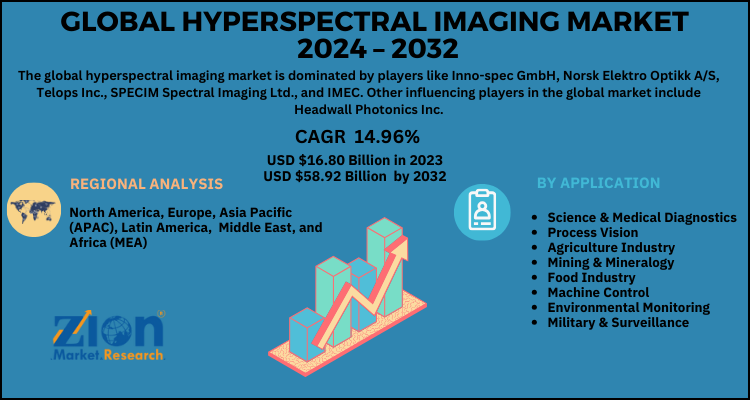Hyperspectral Imaging Market Size, Share, Growth Report 2032

Hyperspectral Imaging Market By Product (Accessories and Camera), By Technology (Push Broom, Snapshot, and Others), By Application (Medical Diagnostics, Remote Sensing, Machine Vision, Military & Surveillance, and Others), And By Region - Global And Regional Industry Overview, Market Intelligence, Comprehensive Analysis, Historical Data, And Forecasts, 2024-2032
| Market Size in 2023 | Market Forecast in 2032 | Growth Rate (in %) | Base Year |
|---|---|---|---|
| USD 16.80 Billion | USD 58.92 Billion | CAGR at 14.96% | 2023 |
Description
According to the report published by Zion Market Research, the global Hyperspectral Imaging Market size was valued at USD 16.80 Billion in 2023 and is predicted to reach USD 58.92 Billion by the end of 2032. The market is expected to grow with a CAGR of 14.96% during the forecast period. The report analyzes the global Hyperspectral Imaging Market ’s growth drivers, restraints, and impact on demand during the forecast period. It will also help navigate and explore the arising opportunities in the Hyperspectral Imaging Market industry.
Global Hyperspectral Imaging Market: Overview
The imaging technique used to collect and process information through electromagnetic spectrum is known as hyperspectral imaging. The main aim of this imaging technique is to produce a spectrum of each pixel of the image to study objects. Hyperspectral imaging is used in the diagnosis of retinopathy, identify & detect contaminants in food and development of crops. It plays an important role in research areas such as nano-drug delivery and nanotoxicology. Hyperspectral imaging is widely used in many applications such as agricultural, science & diagnostics and defense.
Hyperspectral images are formed by using an instrument known as imaging spectrometer. The image is formed at multiple wavelengths and produces three-dimensional hyperspectral data cube along with two spatial dimensions and one spectral dimension. It is capable of measuring the absorption of electromagnetic radiation, reflection, and emission and gives a unique spectral signature for every pixel. It does not require former knowledge of the sample and gaining of the entire spectrum at each point. Hyperspectral imaging is useful in image-guided surgeries and diagnosis of diseases; it also provides broad information for the analysis of the image.
Global Hyperspectral Imaging Market: Growth Factors
Technological advancements may create new growth opportunities in the global hyperspectral imaging market. Some of the key strategies adopted by major companies as joint ventures, mergers & acquisitions, expansions, partnerships, collaborations, and others. Increasing healthcare expenditure and growing number of research projects are anticipated to foster the global hyperspectral imaging market growth.
Moreover, increasing usage of hyperspectral imaging in environmental testing and rising government funding for research activities may positively impact the global market growth. Hyperspectral imaging is largely preferred by the gastrointestinal tract, mucosal membrane analysis, surface tissue, ophthalmology, and vascular system may fuel the global hyperspectral imaging market growth in future. Conversely, reimbursement issues, the requirement of high investments and high installation costs may hinder the global hyperspectral imaging market growth.
Global Hyperspectral Imaging Market: Segmentation
The global hyperspectral imaging market is segmented based on product, technology, application, and region.
Segmentation Analysis by Product
Based on Product, the global hyperspectral imaging market is divided into accessories and cameras. The accessories segment in the hyperspectral imaging market includes a variety of components and peripherals that support and enhance the functionality of hyperspectral cameras. These accessories can range from lighting systems, lenses, and filters to software for data analysis and processing. The demand for accessories is driven by the need for comprehensive and tailored hyperspectral imaging solutions across various applications. These accessories enable users to customize their imaging systems to meet specific requirements, whether in scientific research, agriculture, environmental monitoring, or industrial inspection. The accessories segment is expected to see steady growth.
Camera segment holds the largest share and accounted for approximately 72.6% of the total market revenue in 2023. The hyperspectral camera segment is the core product in the hyperspectral imaging market, capable of capturing and processing information across a wide spectrum of light. These cameras are essential for applications that require detailed spectral information beyond what traditional imaging systems can provide. The hyperspectral camera market is driven by the increasing demand for advanced imaging solutions in various industries. The medical field uses hyperspectral cameras for diagnostics and image-guided surgery.
Segmentation Analysis by Technology
On the basis of Technology, the global hyperspectral imaging market is bifurcated into push broom, snapshot, and others. Push broom segment, also known as line-scan imaging, involves the movement of the sensor or the object to capture a complete image one line at a time. This method is widely used in remote sensing and industrial inspection due to its high spatial and spectral resolution. Push broom hyperspectral imaging systems are highly efficient for capturing detailed images over large areas, making them ideal for applications in agriculture, forestry, environmental monitoring, and mining. The ability to produce high-resolution images with minimal motion artifacts drives the demand for push broom technology in these sectors.
The snapshot segment is projected to experience robust growth. This segment captures the entire hyperspectral cube in a single shot without the need for scanning. This technology is particularly useful for applications requiring rapid data acquisition and analysis. Snapshot hyperspectral imaging systems are gaining popularity in medical diagnostics, food quality inspection, and security applications due to their ability to capture real-time data quickly. The rapid data acquisition capability is crucial for dynamic or fast-moving subjects, making snapshot systems ideal for biomedical imaging and real-time monitoring applications.
Segmentation Analysis by Application
Based on Application, the global hyperspectral imaging market is categorized into medical diagnostics, remote sensing, machine vision, military & surveillance, and others. The medical diagnostics segment is registering growth at a CAGR of 12.7% between 2024 to 2032. Hyperspectral imaging in medical diagnostics involves capturing and analyzing spectral data from tissues and organs to detect diseases and abnormalities. This technology provides detailed spectral information that can help in early disease detection, precise diagnosis, and monitoring of treatment efficacy. The use of hyperspectral imaging in medical diagnostics is driven by its ability to provide non-invasive and highly detailed analysis of biological tissues. It is particularly useful in identifying cancerous cells, detecting retinal diseases, and monitoring skin conditions. The growing demand for advanced diagnostic tools and the increasing prevalence of chronic diseases are significant factors propelling the adoption of hyperspectral imaging in healthcare.
The remote sensing segment of hyperspectral imaging involves capturing spectral data from the Earth's surface to monitor and analyze environmental conditions. This technology is extensively used in agriculture, forestry, geology, and environmental monitoring. Hyperspectral imaging provides valuable insights into vegetation health, soil composition, water quality, and mineral exploration. The ability to capture and analyze a wide range of wavelengths enables detailed and accurate environmental assessments. The growing need for sustainable agricultural practices, natural resource management, and environmental protection is driving the demand for hyperspectral imaging in remote sensing.
In the machine vision segment, hyperspectral imaging is used to inspect and analyze materials and products in industrial processes. This technology helps in identifying defects, ensuring quality control, and improving manufacturing efficiency. The use of hyperspectral imaging in machine vision is driven by the need for high-precision inspection and quality control in industries such as food processing, pharmaceuticals, and manufacturing. The ability to detect minute differences in materials and identify contaminants or defects enhances production quality and safety. The increasing automation of industrial processes and the demand for high-quality products are key drivers of this segment.
The military and surveillance segment accounted for 32.4% of revenue share in 2023. Hyperspectral imaging is used in military and surveillance segments to gather detailed spectral information for reconnaissance, target identification, and threat detection. This technology provides superior capabilities in identifying objects and materials based on their spectral signatures. The adoption of hyperspectral imaging in military and surveillance is driven by the need for advanced imaging technologies that offer high resolution and accuracy in detecting and identifying threats. The ability to capture detailed spectral data enhances situational awareness and supports decision-making in defense operations.
Hyperspectral Imaging Market: Report Scope
| Report Attributes | Report Details |
|---|---|
| Report Name | Hyperspectral Imaging Market Research Report |
| Market Size in 2023 | USD 16.80 Billion |
| Market Forecast in 2032 | USD 58.92 Billion |
| Growth Rate | CAGR of 14.96% |
| Number of Pages | 185 |
| Key Companies Covered | Inno-spec GmbH, Norsk Elektro Optikk A/S, Telops Inc., SPECIM Spectral Imaging Ltd., and IMEC. Other influencing players in the global market include Headwall Photonics Inc., Cubert-GmbH, VK DI Kerschhaggl GmbH, LemnaTec GmbH, and Surface Optics Corp. |
| Segments Covered | By Application and By Region |
| Regions Covered | North America, Europe, Asia Pacific (APAC), Latin America, Middle East, and Africa (MEA) |
| Base Year | 2023 |
| Historical Year | 2018 to 2022 |
| Forecast Year | 2024 - 2032 |
| Customization Scope | Avail customized purchase options to meet your exact research needs. Request For Customization |
Global Hyperspectral Imaging Market: Regional Analysis
The increase in research activities in hyperspectral imaging dominates North America globally. In addition, the rising acceptance of hyperspectral imaging in life sciences and diagnostics, military surveillance, mining, and others may foster global market growth in this region. Increasing healthcare awareness and mining explorations and research activities, in North America positively impact the global market growth. Asia Pacific is anticipated to reflect a higher growth rate in the next few years due to the fastest-growing market in China and India. Moreover, the presence of a large pool of patients and rising pharmaceutical industries in Asia Pacific may account for the largest market share. Furthermore, technological advancements and the rising usage of hyperspectral imaging for carrying out research activities further fuel the growth of the global hyperspectral imaging market in the Asia Pacific.
Global Hyperspectral Imaging Market: Competitive Players
Prominent players in the global hyperspectral imaging market are:
- Inno-spec GmbH
- Norsk Elektro Optikk A/S
- Telops Inc.
- SPECIM Spectral Imaging Ltd.
- IMEC
- Headwall Photonics Inc.
- Cubert-GmbH
- VK DI Kerschhaggl GmbH
- LemnaTec GmbH
- Surface Optics Corp.
The Global Hyperspectral Imaging Market is segmented as follows:
By Product Segment Analysis
- Accessories
- Camera
By Technology Segment Analysis
- Push Broom
- Snapshot
- Others
By Application Segment Analysis
- Medical Diagnostics
- Remote Sensing
- Machine Vision
- Military & Surveillance
- Others
By Region Segment Analysis
- North America
- U.S.
- Europe
- UK
- France
- Germany
- Asia Pacific
- China
- Japan
- India
- Latin America
- Brazil
- The Middle East and Africa
What Report Provides
- Full in-depth analysis of the parent market
- Important changes in market dynamics
- Segmentation details of the market
- Former, on-going, and projected market analysis in terms of volume and value
- Assessment of niche industry developments
- Market share analysis
- Key strategies of major players
- Emerging segments and regional markets
- Testimonials to companies in order to fortify their foothold in the market.
Table Of Content
HappyClients
Zion Market Research
Tel: +1 (302) 444-0166
USA/Canada Toll Free No.+1 (855) 465-4651
3rd Floor,
Mrunal Paradise, Opp Maharaja Hotel,
Pimple Gurav, Pune 411061,
Maharashtra, India
Phone No +91 7768 006 007, +91 7768 006 008
US OFFICE NO +1 (302) 444-0166
US/CAN TOLL FREE +1 (855) 465-4651
Email: sales@zionmarketresearch.com
We have secured system to process your transaction.
Our support available to help you 24 hours a day, five days a week.
Monday - Friday: 9AM - 6PM
Saturday - Sunday: Closed







